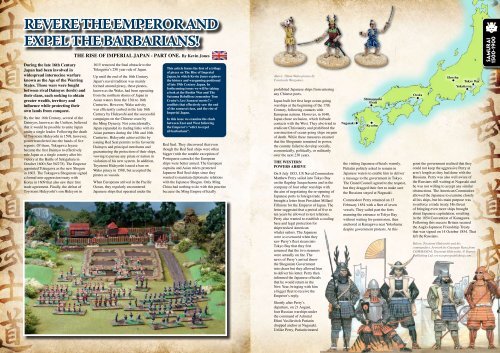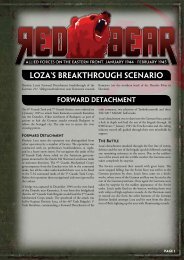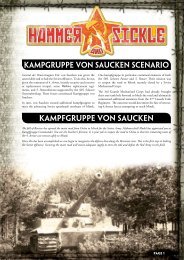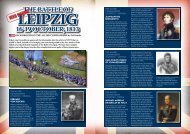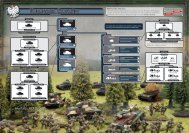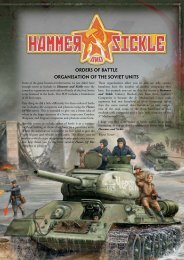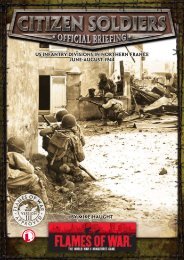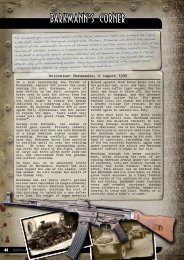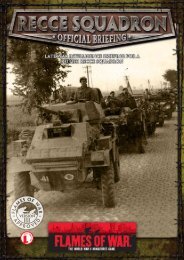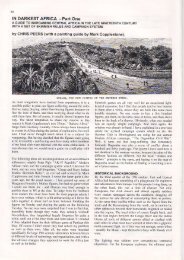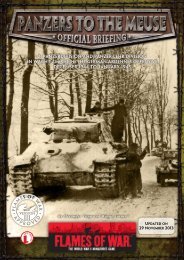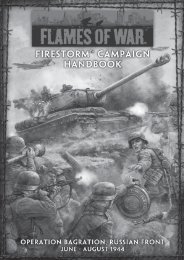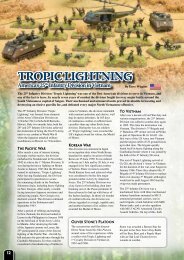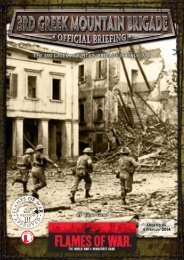Download a PDF version of this article here... - Flames of War
Download a PDF version of this article here... - Flames of War
Download a PDF version of this article here... - Flames of War
- No tags were found...
You also want an ePaper? Increase the reach of your titles
YUMPU automatically turns print PDFs into web optimized ePapers that Google loves.
Revere the Emperor andexpel the Barbarians!During the late 16th CenturyJapan had been involved inwidespread internecine warfareknown as the Age <strong>of</strong> the <strong>War</strong>ringStates. Those wars were foughtbetween rival Daimyos (lords) andtheir clans, each seeking to obtaingreater wealth, territory andinfluence while protecting theirown lands from conquest.By the late 16th Century, several <strong>of</strong> theDaimyos, known as the Unifiers, believedthat it would be possible to unite Japanunder a single leader. Following the death<strong>of</strong> Toyotomi Hideyoshi in 1598, however,power transferred into the hands <strong>of</strong> fiveregents. Of them, Tokugawa Ieyasubecame the first Daimyo to effectivelyrule Japan as a single country after hisvictory at the Battle <strong>of</strong> Sekigahara inOctober 1600 (See WI278). The Emperorappointed Tokugawa as the new Shogunin 1603. The Tokugawa Shogunate signeda formal non-aggression treaty withKorea in 1609 that also saw their firsttrade agreement. Finally, the defeat <strong>of</strong>Toyotomi Hideyoshi’s son Hideyori inThe Rise <strong>of</strong> Imperial Japan - Part One. By Kevin Jones1615 removed the final obstacle to theTokugawa’s 250 year rule <strong>of</strong> Japan.Up until the end <strong>of</strong> the 16th CenturyJapan’s naval tradition was mainlyformed around piracy, these pirates,known as the Wako, had been operatingfrom the northern shores <strong>of</strong> Japan inAsian waters from the 13th to 16thCenturies. However, Wako activitywas efficiently curbed in the late 16thCentury by Hideyoshi and the successfulcampaigns on the Chinese coast bythe Ming Dynasty. Not coincidentally,Japan expanded its trading links with itsAsian partners during the 15th and 16thCenturies. Hideyoshi achieved <strong>this</strong> byissuing Red Seal permits to his favouriteDaimyos and principal merchants andguaranteeing the protection <strong>of</strong> their ships,vowing to pursue any pirate or nation inviolation <strong>of</strong> his new system. In addition,Toyotomi Hideyoshi issued a ban onWako piracy in 1588, but accepted thepirates as vassals.When Europeans arrived in the PacificOcean, they regularly encounteredJapanese ships that operated under theThis <strong>article</strong> forms the first <strong>of</strong> a trilogy<strong>of</strong> pieces on The Rise <strong>of</strong> ImperialJapan, in which Kevin Jones exploresthe history and wargaming positional<strong>of</strong> late 19th Century Japan. Inforthcoming issues we will be takinga look at the Boshin <strong>War</strong> and TheSatsuma Rebellion (remember TomCruise’s Last Samurai movie?) -conflicts that effectively saw the end<strong>of</strong> the samurai class, and the rise <strong>of</strong>Imperial Japan.In <strong>this</strong> issue we examine the clashbetween East and West followingthe Emperor’s “edict to expelall barbarians”.Red Seal. They discovered that eventhough the Red Seal ships were <strong>of</strong>tenbigger (with the notable exception <strong>of</strong>Portuguese carracks) the Europeanships were better armed. The Europeancaptains and Asian rulers protectedJapanese Red Seal ships since theywanted to maintain diplomatic relationswith the Japanese Shogun. Only MingChina had nothing to do with <strong>this</strong> practisebecause the Ming Empire <strong>of</strong>ficiallyAbove: 28mm Wako pirates byCavalcade <strong>War</strong>games.prohibited Japanese ships from enteringany Chinese ports.Japan built her first large ocean-goingwarships at the beginning <strong>of</strong> the 17thCentury, following contacts withEuropean nations. However, in 1640,Japan chose seclusion, which forbadecontacts with the West. They also tried toeradicate Christianity and prohibited theconstruction <strong>of</strong> ocean-going ships on pain<strong>of</strong> death. While these measures ensuredthat the Shogunate remained in power,the country failed to develop socially,economically, politically, or militarilyover the next 230 years.The WesternPowers ArriveOn 8 July 1853, US Naval CommodoreMatthew Perry sailed into Tokyo Bayon the flagship Susquehanna and in thecompany <strong>of</strong> four other warships withthe aim <strong>of</strong> negotiating the re-opening <strong>of</strong>Japanese ports to foreign trade. Perrybrought a letter from President MillardFillmore for the Emperor <strong>of</strong> Japan. Theletter suggested that a period <strong>of</strong> five toten years be allowed to test relations.Perry also wanted to establish a coalingbase and legal protection forshipwrecked Americanwhaler sailors. The Japanesewere so overawed when theysaw Perry’s fleet steam intoTokyo Bay that they firstassumed that the two steamerswere actually on fire. Thenews <strong>of</strong> Perry’s arrival threwthe Shogunate Governmentinto chaos but they allowed himto deliver his letter. Perry theninformed the Japanese <strong>of</strong>ficialsthat he would return in theNew Year, bringing with hima bigger fleet to receive theEmperor’s reply.NagasakiShimonosekiStraitKyushuthe visiting Japanese <strong>of</strong>ficials warmly.Putiatin politely asked to remain inJapanese waters to enable him to delivera message to the government in Tokyo.The Grand Council agreed to the request,but they dragged their feet to make surethe Russians stayed at Nagasaki.Commodore Perry returned on 13February 1854 with a fleet <strong>of</strong> sevenvessels. They sailed past the fortsmanning the entrance to Tokyo Baywithout waiting for permission, thenanchored at Kanagawa near Yokohamadespite government protests. At <strong>this</strong>OsakaHonshuYokohamaTokyo Baypoint the government realised that theycould not keep the aggressive Perry atarm’s length as they had done with theRussians. Perry was also well aware <strong>of</strong>the Russians still waiting at Nagasaki andhe was not willing to accept any similarobstructions. The American Commodoreallowed the Japanese to examine closelyall his ships, but his main purpose wasto enforce a trade treaty. His threat<strong>of</strong> bringing even more ships broughtabout Japanese capitulation, resultingin the 1854 Convention <strong>of</strong> Kanagawa.Following <strong>this</strong> success Britain securedthe Anglo-Japanese Friendship Treatythat was signed on 14 October 1854. Thatleft the Russians.Below: Toyotomi Hideyoshi and hiscommanders. Artwork by Giuseppe Rava fromCOMMAND 6, Toyotomi Hideyoshi, © OspreyPublishing Ltd. www.ospreypublishing.comNapoleonic SAMURAI <strong>War</strong>s1803-1815 1500-1900Shortly after Perry’sdeparture, on 21 August,four Russian warships underthe command <strong>of</strong> AdmiralEfimi Vasilievitch Putiatindropped anchor at Nagasaki.Unlike Perry, Putiatin treated
Napoleonic <strong>War</strong>s1803-1815Above: The first landing <strong>of</strong> troops under U.S.Naval Commodore Matthew Perry.Left: A comtemporary Japanese watercolour<strong>of</strong> one <strong>of</strong> Perry’s steamships.At the end <strong>of</strong> 1854, Putiatin returned,arriving at Osaka in November. He againasked politely to meet the Emperorand deliver a message from the Czar.The government asked him to anchor<strong>of</strong>f Shimoda, 60 miles from TokyoBay then entered into negotiations.However, on 23 December a massiveearthquake struck, seriously damagingPutiatin’s ship, the Diana. The Russiansent his men ashore to aid the Japanesevictims, so that when he asked forpermission to sail to a safe harbour toeffect repairs the grateful governmentagreed. Unfortunately, the Diana sankshortly afterwards in another storm. TheRussians spent the winter building twonew schooners, while also instructingthe Japanese in the modern methods<strong>of</strong> shipbuilding. On 7 February 1855Putiatin presented the salvaged gunsfrom the Diana to the governmentand concluded a similar treaty tothe Americans, with one importantdifference; the Russian treatygranted extraterritorial privilegesfor Russian citizens.The Japanese ReactionAlthough the treaties were good forAmerica and Russia, many Japanesebecame quickly disaffected. Inflationsoon swept the country and the Japanesefelt disrespected by their Europeanguests. The powerful Samurai class,who opposed the decision to deal withthe West, were now annoyed with theweak and ineffective government. Thatwould soon turn to openly expressedanger when the Americans, stung bythe concessions given to the Russians,demanded equal treatment. Moreover,the British, French, and Dutch got in onthe action, negotiating deals that alongwith those given to Russian and Americabecame known as the Ansei Treaties, andto the Japanese the Unequal Treaties.All the major western powers now held“most favoured nation” status in Japan.The Shogunate’s problems with foreignpowers were mirrored by internaldifficulties. The 1850s was a decade<strong>of</strong> weak leadership at a crucial turningpoint in Japanese history. From thatweakness emerged two main factions,the reformers and traditionalists. T<strong>here</strong>formers accepted the need for changeand modernisation and wanted a strongJapan to manage western influences. Thetraditionalists wanted to continue theTokugawa line and manufactured a set<strong>of</strong> purges, known as the Ansei purges,resulting in the removal <strong>of</strong> over 100<strong>of</strong>ficials from their posts. This turbulencealso brought the Imperial Court into thepolitical field, and some Daimyos sidedwith the restoration <strong>of</strong> the Imperial Courtagainst the Shogunate. On 3 March1860, a group <strong>of</strong> Samurai assassinatedthe Shogun, forcing the government tobring in limited reforms and work withthe Emperor to bring in changes. Neitherside stayed happy for long, however, andunrest continued well into the 1860s.Below: Woodblock from 1861 showing a sumowrestler at Yokohama following theinstructions <strong>of</strong> the Emperor (literally!) andthrowing a foreigner out <strong>of</strong> the country.On 25 June 1862, the Emperor issuedan edict to expel all barbarians fromJapan, giving foreigners exactly oneyear to leave. Although the Shogunateacknowledged the order, they couldnot enforce it. This inactivity by theShogunate became the opportunity thatthe reformists, aided by the ImperialCourt, needed to openly oppose thegovernment. Not long afterwards, inSeptember 1862, Japan’s internal politicalcrises became <strong>of</strong> global concern whenmen under the orders <strong>of</strong> the SatsumaDaimyo, Shimazu Hisamitsu, attackeda group <strong>of</strong> three British tourists nearYokohama, killing two <strong>of</strong> them. Thisbecame known as the NamamugiIncident. The British demanded anindemnity <strong>of</strong> £110,000 from theGovernment and £25,000 from Satsuma:the Government paid up, but Shimazurefused. The result <strong>of</strong> the NamamugiIncident, Shimazu’s refusal, added to thesubsequent actions <strong>of</strong> the Choshu clan,led to a brief but violent war between thetwo clans and the united western powers.Gunboat Diplomacyin ActionThe Choshu clan followed the Emperor’sedict and started to expel all foreignersfrom their province before the June1863 deadline. In addition to expulsions,Above: 28mm Adake-Bume boat by Scheltrum Miniatures. Typical <strong>of</strong> the vessels built bythe Japanese in the 16th and 17th Centuries.however, the Choshu Daimyo orderedthe bombardment <strong>of</strong> any western vesselentering the 112 metre wide ShimonosekiStrait, separating the islands <strong>of</strong> Kyushuand Honshu. That made fightinginevitable because the western naviesregularly used <strong>this</strong> strait as a shortcut tothe ports <strong>of</strong> Osaka and Tokyo.The first attacks came immediately on theexpiration <strong>of</strong> the deadline when Choshuships attacked the American merchantsteamer SS Pembroke. The following day,Choshu shore batteries inflicted damageon the French steamer Kienchang. Bothships escaped with little damage, but afew days later the Dutch warship Medusacame under attack and sustained severalcasualties. Retaliation was not long incoming, but it was an American vessel,the USS Wyoming, that took the fight tothe Choshu. The Wyoming sailed intothe strait on 16 July and, ignoring theineffectual shore batteries, proceededto sink two Choshu ships and damageanother with only four men lost on herside. The French quickly followed on20 July when the Tancrede and Dupliexbombarded the town <strong>of</strong> Shimonoseki anda shore battery.For their part, the British remainedintent on collecting the Satsumaindemnity. On 15 August, Vice AdmiralAugustus Leopold Kuper led sevenwarships towards the Satsuma capital <strong>of</strong>Kagoshima. His powerful fleet consisted<strong>of</strong> HMSs Euryalus, Pearl, Perseus,Argus, Coquette, Racehorse, and Havoc,mounting 109 guns between them. Kuperseized three Satsuma merchant steamboats to effect payment, but when theKagoshima shore batteries opened up, theAdmiral ordered them to be sacked andsunk. The squadron then formed a line <strong>of</strong>battle and steamed along the Kagoshimaport, firing shell and round shot at theSatsuma defences and the town. Althoughthe Satsuma batteries continued to fire,the British guns had a far further reachthan the old Satsuma guns and beingsafely out <strong>of</strong> range they bombarded andsilenced the batteries, and damaged atleast 500 homes in the town. The damageto the town could have been caused dueto the rolling <strong>of</strong> the ships in what wasnow very foul weather. The shots wereoriginally aimed for the batteries, butthese passed over them and struck thetown. The British lost a total <strong>of</strong> 13 men
including the Flag Captain, Captain JohnJosling and the First Officer, CommanderEdward Wilmot <strong>of</strong> HMS Euryalus withanother 39 wounded. After the battle theSatsuma agreed to pay the indemnity tothe British.Following the above attacks, the westernpowers entered into negotiations withthe Japanese authorities during early1864. The aim <strong>of</strong> the talks was to allowwestern shipping to use the ShimonosekiSTRAITS OF SHIMONOSEKI5 - 8 SEPTEMBER 1864KEYShore Batteries8SeptNStraits and t<strong>here</strong>by allow trade to beconducted in accordance with the varioustreaties. Despite ongoing negotiations andthreats <strong>of</strong> action by the western powers,however, the Choshu clan continuedto fire on western shipping using thestraits. On 29 August, Admiral Kuper leda multi-national force from YokohamaHarbour. The fleet consisted <strong>of</strong> ten Britishvessels, HMS Euryalus, Conqueror,Leopard, Tartar, Barrosa, Perseus,Argus, the gunboats Coquette and7SeptTanouraShimonoseki6Sept5SeptAdvancedSquadronMainSquadronSamuraiBarracksLightSquadronToyouraBouncer, and the collier Pembrokeshire,together with three French vessels, theSemiramis, Dupleix, and Tancrede; fourDutch vessels, the corvettes Medusa,Metalen Kruis and Djambi, and thepaddle sloop Amsterdam; and a tokenAmerican vessel the Takiang, a charteredsteamer with a single gun.Kuper’s fleet arrived <strong>of</strong>f HimesimaIsland on 4 September and by thefollowing day had deployed into theirallocated positions in three squadrons.The Main Squadron consisted <strong>of</strong> theEuryalus, Semiramis and the Conquerorwith a battalion <strong>of</strong> marines onboard. TheTartar, Dupleix, Metalen Kruis, Barrosa,Djambi and the Leopard made up theAdvanced Squadron. That left the LightSquadron, consisting <strong>of</strong> the Perseus,Medusa, Tancrede, Coquette, Bouncer,Argus, Amsterdam, Takiang and thePembrokeshire.The attack started in the early afternoonwhen the Advance Squadron movedinto the left hand side <strong>of</strong> the bay <strong>of</strong>f thevillage <strong>of</strong> Tanoura and opened fire onseveral batteries below the heights <strong>of</strong>Toyoura. They were joined by the MainSquadron ships occupying the centre.They also opened fire on the Toyourabatteries. The Light Squadron enteredthe fray on the right-hand side <strong>of</strong> thebay, and t<strong>here</strong>fore closest to the enemy.By 16:30 the combined fleet had silencedthe fire from at least two <strong>of</strong> the batteriesand an hour later they had silencedthree additional forts. During the earlyevening several shore parties weresent in to spike the remaining guns,which they did without sufferingany casualties.The action continued the next day whenat daylight the Choshu guns opened fireon the Tartar and Dupleix <strong>of</strong> the AdvanceSquadron, causing some minor damage.The Advance Squadron returned fire andsoon silenced the battery.The operation then shifted to landingthe battalion <strong>of</strong> 600 marines under thecommand <strong>of</strong> Colonel William GrigorSuther RM from HMS Conqueror,together with 900 seamen <strong>of</strong> the NavalBrigade from Euryalus and Conquerorunder the command <strong>of</strong> Captain JohnHobhouse Inglis Alexander RN, togetherwith Lieutenant Harington RN andMidshipmen Duncan Boyes. The Britishforce was supplemented by 350 Frenchseamen and marines under the command<strong>of</strong> Captain Du Quilis and LieutenantLayrle, and 200 Dutch under thecommand <strong>of</strong> Lieutenant Binkis.The attacks onthe Choshu Guns andShimonoseki BarracksThe infantry force went ashore underorders to capture the batteries north <strong>of</strong>Toyoura. The attack was a great successwith the party meeting only limitedopposition: the batteries were renderedunusable; the guns spiked; gun carriagesand platforms burnt; and the magazinesdestroyed. With everything seeminglyaccomplished, the force was orderedto embark before nightfall. The Frenchand Dutch companies had just embarkedon-board their vessels, when the NavalBrigade stationed at a battery near theShimonoseki samurai barracks wasattacked by Choshu Samurai.Colonel Suther’s battalion <strong>of</strong> marineswere sent in to drive the enemy back,which was achieved with ineffectiveresistance on the part <strong>of</strong> the Japanese.The marines also went on to capture anearby stockade barracks. The joint forcewas then recalled and successfully reembarkedon the fleet, although CaptainAlexander had been seriously wounded inthe attack.The following day shore parties were givenorders to start to embark the captured gunsfrom eight batteries. During the afternoonthe Advanced Squadron moved north, west<strong>of</strong> Moji Saki point to prepare for furtherattacks on other Choshu emplacements.The Squadron opened fire on the morning<strong>of</strong> 8 September and quickly silenced theguns. Parties were then sent ashore withorders to destroy the emplacements andembark the captured guns. The operationto embark the guns took several days, butby 10 September it was completed with atotal haul <strong>of</strong> 62 guns.While <strong>this</strong> operation was ongoing,Admiral Kuper opened negotiations withthe Choshu aboard the fleet’s flagship.After two days <strong>of</strong> talks, the Choshuformally apologised, agreeing not to erectany further costal defences and to openthe straits to western shipping.During the action the fleet had lost 12killed and 60 wounded; most <strong>of</strong> thosewere taken during the shore action on 6September. It was during <strong>this</strong> action thata total <strong>of</strong> three Victoria Crosses wereearned, one by Midshipman DuncanGordon Boyes <strong>of</strong> the Euryalus;“who carried a colour with the leadingcompany, kept it with headlong gallantryin advance <strong>of</strong> all, in face <strong>of</strong> the thickestfire, his colour-sergeants having fallen,one mortally and the other dangerouslywounded, and was only detained fromproceeding further yet by the orders <strong>of</strong>his superior <strong>of</strong>ficer. The colour he carriedwas six times pierced by musket balls.”The other VCs went to Thomas Pride,captain <strong>of</strong> the afterguard, who until hefell disabled had supported Boyes; andWilliam Seeley, an American seaman whodaringly ascertained the position <strong>of</strong> theenemy, and afterwards, though wounded,continued in the front <strong>of</strong> the advance.The operations in the Shimonoseki Straitwere a complete success for the westernpowers, the allies losing only 72 killedand two ships damaged. Needless to say,defeat had a more sobering effect on theJapanese, but they would quickly learnfrom their mistakes.Below: The war in Japan: The Naval Brigade and Marines storming the stockade at Shimonoseki.Illustration from The Illustrated London News 1864.Napoleonic <strong>War</strong>s1803-1815Left, Top: a map <strong>of</strong> the Straits <strong>of</strong> Shimonosekishowing the lines <strong>of</strong> the Allied attacks.Middle and Bottom: Western and Easternartwork depicting the attacks.
wargaming The Battle forthe CHOSHU GunsThis scenario is based on the land actionat Shimonoseki on 6 September 1862,which is covered on the previous page.Following a successful operation in whicha landing party <strong>of</strong> French, Dutch andBritish troops had put ashore and captureda Japanese gun battery near Toyoura, someBritish sailors w<strong>here</strong> in the process <strong>of</strong>spiking and dismantling the enemy’s gunswhen they were set upon by a force <strong>of</strong>Choshu Samurai who had ridden out froma nearby barracks/stockade in an attemptto drive <strong>of</strong>f the barbarians.OBJECTIVES, SETUP ANDADDITIONAL RULESChoshuThe Choshu samurai player’s task is touse his mounted warriors to launch an allout assault against the British and drivethem <strong>of</strong>f the table, or into the sea.The game starts with the Samurai (whomove first) being placed on the tablewithin charge range <strong>of</strong> either or both <strong>of</strong>the two batteries or the Naval Brigade,whichever is the closer.BritishThe British player force consists <strong>of</strong> agroup <strong>of</strong> sailors who are in the process<strong>of</strong> dismantling the enemy’s two shorebatteries and a Naval Brigade who arestationed in support (just in case anyChoshu should attack!)The Naval Brigade must be deployed nomore than half a move away from theguns/sailors. The British player deployshis force on the table first.Not far away a unit <strong>of</strong> Royal Marines(RMLI) have been destroying anotherChoshu shore battery and they may returnat any moment, or at least any turn.For the RMLI to enter the game throw1D6 each turn - a 6 rolled in the first turnmeans they have arrived on the scene, a 5or 6 in the second, a 4, 5 or 6 in the third,and so on.The RMLI enters the table on the westernroad approaching the first shore battery.The two shore batteries should be placedmore than 12 inches apart, so that one<strong>of</strong> the shore parties will be ‘Out <strong>of</strong>Command’, unless the player uses CaptAlexander RN (the Naval C-in-C) to betheir command element.Only Col Suther RM can rally any RMLIrouters and only Capt Alexander RN canrally any Royal Naval routers.The British player’s objective is to drive<strong>of</strong>f the Samurai.AFTERMATHFollowing <strong>this</strong> action the RMLI and NavalBrigade went on to attack the nearbybarracks/stockade. This action would alsomake for an interesting wargame.uniformsThe RMLI wore a white cap with anattached plain white neck cloth. This wasthe same hat that was being worn by theEast India Company and the British forcesin India at the time, when they were notwearing the pith helmet.Under the Amendments to Naval Regulationsin 1857 the uniforms were as follows:SeamenBlue Cloth Jacket: To be made <strong>of</strong> NavyBlue Cloth, double breasted, with standand fall collar, sleeves sufficiently largeto go easily over a Duck and Serge Frock,to reach to the hip, with an opening at theCuffs on the seam, with two small blackbuttons, one inside breast pocket on theleft side.Blue Cloth Trowsers: To be made <strong>of</strong> NavyBlue Cloth, <strong>of</strong> the ordinary Naval Pattern,fitting tight at the waistband, with twopockets and a broad flap, and black uniformbuttons, identical to those on the jacket.Duck Trowsers: To be made <strong>of</strong> whiteDuck cloth, in a similar manner to theBlue Trowsers, with white metal dead-eyebuttons on them.Hat: To be black or white, according toclimate. The hat to be 4'' high in the crown, 3''wide in the rim, and seven inches across thecrown, and made <strong>of</strong> Sennet [Straw], coveredwith brown Holland painted black, with a hatribbon bearing the ship’s name; and in warmclimates the same hat uncovered. A chin-stayto be attached to the hat.Royal Marine Light InfantryTunic, Scarlet Cloak.-Eight buttons up frontat equal distances, skirts closed behind,with back slashes edged with white, eachhaving three large uniform buttons. Collarand cuffs <strong>of</strong> blue cloth, collar rounded infront, and having a row, <strong>of</strong> 5/8'' gold-wirelace at top under white edging. Colonels towear for collar badges, embroidered crownsand stars; Lieutenant-Colonels crowns;Majors, stars; Captains crowns and stars;Lieutenants, crowns.Trowsers, Undress, Winter. - Blue cloth withscarlet welt, ¼'' wide, down each seam.FiguresHaving extensively looked for figures for <strong>this</strong>period, t<strong>here</strong> seems to be no manufacturerthat produces British wearing the white capand neck cloth. The figures for the RoyalMarines that were in India during the IndianMutiny are modelled wearing a pith helmet.Likewise the figures for the Naval Brigadeare modelled with the seamen wearing theirSennet hats and not the bonnets as depictedin the Illustrated London News drawing. I didfind one manufacturer that produced someEast India Company/British Battalion in28mm wearing the white cap, but they werealso wearing the loose white trousers thatwere used in India.However, several manufacturers do figures<strong>of</strong> the Boxer Rebellion at the turn <strong>of</strong> the 20thCentury. T<strong>here</strong>fore I have used the RoyalMarine figures wearing a forage cap and forthe Naval Brigade I have used French sailors(who had the same square rig uniform asshown in the drawing). These figures justneeded some remodelling with the hatbandtails being removed from the caps.Napoleonic <strong>War</strong>s1803-1815Above: The photo above shows figures from the author’s 15mm collection in action during the attack on the Chosha barracks. On the previous pageare three photos showing scenes from the ‘Attack on the Chosha Guns’ scenario..netCheck out the WI website to findOrders <strong>of</strong> Battle for <strong>this</strong> scenari<strong>of</strong>or the Volley and Bayonet rule set.


